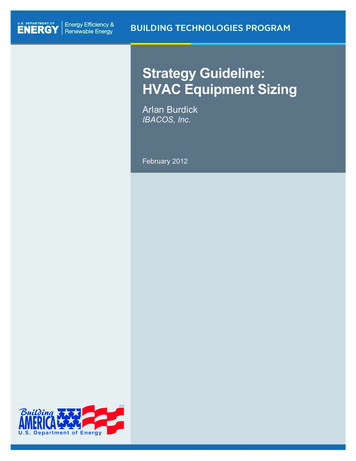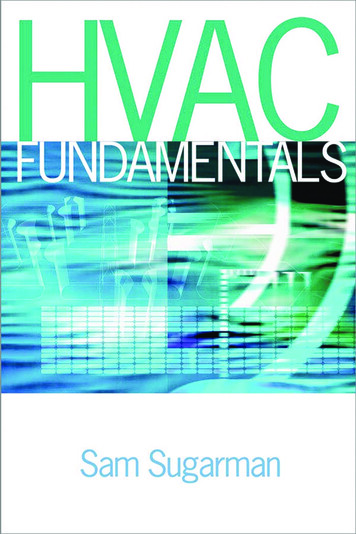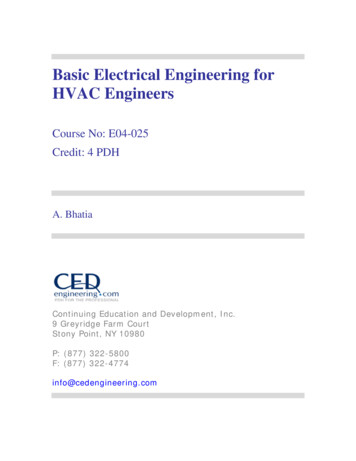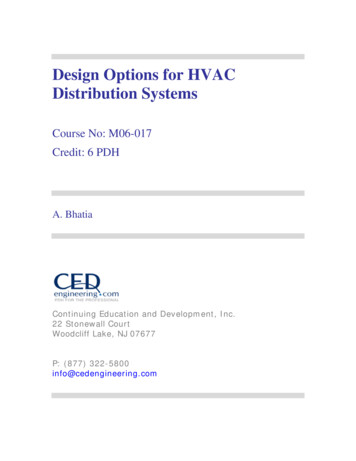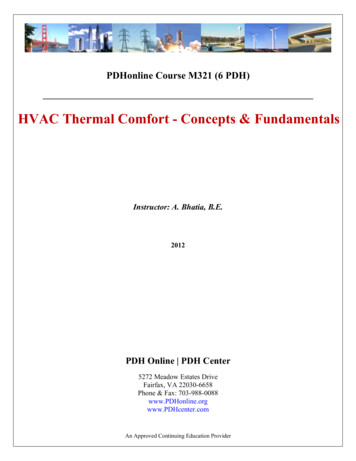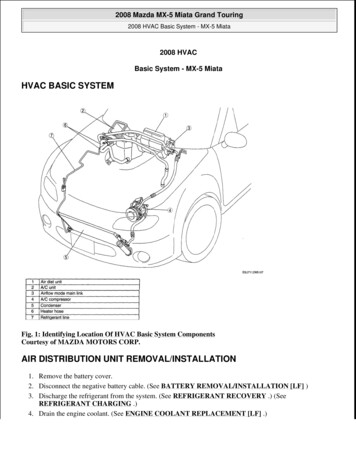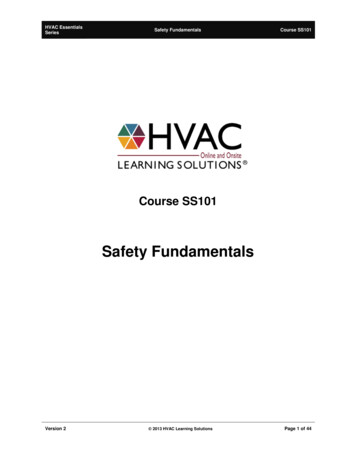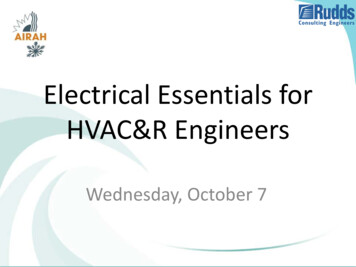
Transcription
Electrical Essentials forHVAC&R EngineersWednesday, October 7
Main Components of anElectrical System
Accessibility of SwitchboardsAS/NZS 3000-2007 REQUIRES SWITCHBOARDS TO HAVE ADEQUATE SPACETO ALLOW EQUIPMENT TO BE SAFELY OPERATED AND ADJUSTEDANDWITH SUFFICIENT EXIT FACILITIES TO ALLOW A PERSON TO LEAVE IN EMERGENCYCONDITIONSIN VERY SIMPLE TERMS THIS REQUIRES 600 mm CLEARANCE ALL AROUND WITH DOORSIN THE OPEN POSITIONS
FIGURE 2.16 FROM AS/NZS 3000-2007
FIGURE 2.17 FROM AS/NZS 3000-2007
FIGURE 2.15 FROM AS/NZS 3000-2007
FIGURE 2.16 FROM AS/NZS 3000-2007
Large Switchboards AS/NZS 3000 requires that any large switchboard be located in a roomwith two egress paths. What is a large switchboard?– A current rating of over 800 Amps.– A short circuit current of over 16kA.– A length of over 3m. Multiple switchboards located side by side over 3m are considered to be a large switchboard. Exception:– FAQ 030/2009: AS/NZS 3000:2007—CLAUSE 2.9.2.2(c)(ii) allows a large switchboard tohave only a single egress path if a clearance of 3 metres is provided around theswitchboard and its equipment, including switchboard doors, in all normal positions ofoperating, opening and withdrawal.
Diversity and Maximum Demand What is diversity?– Diversity is an allowance that all connected equipment will not operate at full load atthe same time. Maximum Demand is the sum of the connected loads with diversityapplied. How to determine diversity?– AS/NZS 3000 Table C2 provides diversity calculations.
Diversity and Maximum Demand
Maximum Demand How to determine the full load of a motor?1.2.3. Use the motor AOM rated power. Maximum that can be drawn by the motor. Will result in oversized electrical infrastructure. 4.4kW from fan data.Use the motor IEC power from nameplate. Will be conservative but closer to the operating point than AOM. Will still result in oversized electrical infrastructure but not as much. 4kW from data sheet.Calculate operating point from data sheet. Is the maximum that the fan will draw in the design condition. Gives the best match of electrical infrastructure to mechanical demand. Calculated by taking the fan absolute power and dividing by motorefficiency. 3.23/0.896 3.6kW from data sheet.Redundant or duty/standby equipment–Calculate maximum demand only on equipment that operates. Ifa system is N 1 then calculate maximum demand on N.–If duty/standby then calculate maximum demand using only theduty unit.High duty installations–Make the electrical designers aware if multiple items will operateat full load together e.g. Data centre, be aware of Table C in theseenvironments.
Voltage Drop What is voltage drop?–The reduction in voltage caused by current flow in the cables. Determined by ohms law, V IR. Also dependent on power factor, typically lower power factor gives higher voltage drop. Why is voltage drop a problem?– AS/NZS 3000 mandates maximum voltage drop of either 5% or 7%. 5% for shared and off-site substations. 7% for dedicated on-site substations.– Can stop DOL or delta-star motors from starting. Too high a volt drop results in insufficient torque to start the motor. DOL motors in particular have high starting current and low power factor resulting in high volt drop. Correct voltage drop calculations require a knowledge of the entireelectrical system from the substation to the load. Can be a problem formechanical contractors if the electrical data is not provided.
Harmonics What are harmonics?–Higher frequency components that add together to create a distorted waveform. Are always multiples of the fundamental frequency of 50Hz. Usually referred to by their harmonic number. –3rd harmonic 3 x 50Hz 150Hz–4th harmonic 4 x 50Hz 200Hz–5th harmonic 5 x 50Hz 250Hz etc.Usually only odd numbered harmonics are present; 3, 5, 7, 9 etc.Why are harmonics a problem?–High frequency components cause excessive power loss and heating in motors,capacitors, transformers etc.–Triplen harmonics (multiples of 3 such as 3, 9, 15 etc.) add in neutral cables and cancause overloads.
Harmonics What are the sources of harmonics?–VSDs are the number one source of harmonics in a typical building.
Harmonic SolutionsSummaryPassive: Built-in as Standard Practical / EasyDC-InductorsAC-inductorsy12 & 18-pulse/// Low cost Robust///dDActive:0%///-20%Advanced HarmonicFilters Low cost Robust EfficientVSD Design Best PracticeSizableHigh mitigationRetrofit-ableEfficient (sleep mode)Active filter &Low Harmonic Drive 20%D Active Front End CompactEasy to spec.High mitigation100% Regenerative26 May 2014 48
IntroductionSources of EMIRFIHarmonics Harmonics cover frequenciesfrom 50Hz to 2.5kHz (50thharmonic)Standard: AS61000-3VSD Design Best Practice RFI is Conducted up to 30MHz,airborne over 30MHzStandard: AS61800-3 (up to 30MHz)26 May 2014 4
EffectsWorst case Without a screen the motor cable radiates RFICommon mode currents travel back to the drive via the earth connections,through the motor (potential bearing failure)This also causes problems for sensitive equipment on the mains supply alsoconnected to the earth point i.e. instrumentationVSD Design Best Practice26 May 2014 10
SolutionsLimiting conducted RFIConducted RFI from the motor travels back to its source along the motorcable screen therefore motor cable screen MUST BE TERMINATED ATBOTH ENDSRFI filter provides a low impedance path for the RFI noise to travel backto it’s sourcer i.e. the d ive. WithoutF the R I filter Fthe R I noise tries to travelback to source through the mainsReduction of Capacitive and Inductive coupling into other cables (comms /signal) can be achieved by physical separation of cablesVSD Design Best Practice26 May 2014 15
SolutionsEMC glands – PigtailsPigtailsgneed to be avoided as they:Act as antennae radiating noiseIncrease the screen impedance, and soincrease conducted noise on mainssupplyOn signal cables Pigtails receive EMI fromother circuitsEMC cable glands ensure a good highfrequency connection of the shieldEMC cable glands should be used at themotor terminal boxVSD Design Best Practice26 May 2014 16
EMC StandardsIEC/EN61800-3 – EnvironmentsVSD Design Best Practice26 May 2014 20
EMC StandardsCategory ClassificationVSD Design Best Practice AS/NZS CISPR11 / EN55011 is astandard which defines limitsaccording to the basic environment,it used to be the only standardwhich could be applied to electricaldrives AS61800-3 (AKA EN/IEC61800-3) isa specific standard for electricaldrive systems Facility operators must comply withAS/NZS CISPR11 / EN55011 – Drivemanufacturers must comply withEN61800-3.26 May 2014 21
Earthing What is earthing?– Why earth the electrical system?– The connection of the general electrical installation to the ground.To protect against indirect contact by the automatic disconnection of supply. Indirect contact is contact with conductive parts that are not normally live but may become live in a fault situationsuch as a phase to earth fault. Automatic disconnection of supply is the tripping of a protective device such as a circuit breaker or fuse by the currentproduced by a phase to earth fault (earth fault loop).How is the electrical system earthed?–By a continuous conductor connected to the exposed conductive part to an earth stake or earth mat.–By the connection of the electrical system neutral conductor to earth at a single point in the electricalinstallation (MEN link).Equipotential bonding–Electrical connections intended to bring exposed conductive parts or extraneous conductive parts to thesame or approximately the same potential, but not intended to carry current in normal service.
Earth Fault Loop The earth fault loop is the series ofconductors that the currentgenerated by an earth fault mustpass through.
Earth Fault Loop Impedance What is earth fault loopimpedance?– The impedance to current flow ofthe earth loop.– Determines how much current flowsfor an earth fault.– Determines the disconnect time inconjunction with the protectivedevice setting.
Earth Fault Loop Disconnect Times AS/NZS 3000 mandates disconnect times for various parts of the electricalinstallation. An earth fault must be disconnected within 0.4s (400ms) for:– Socket-outlets having rated currents not exceeding 63 A; or– hand-held Class I equipment (equipment have a conductive outer case connected toearth); or– (iii) portable equipment intended for manual movement during use. An earth fault must be disconnected within 5s for all other equipment.
How to Determine Disconnect Times AS/NZS 3000 Table 8.1 showsmaximum line impedances forvarious types of breakers. Line impedances can be determinedby measurement. Only provides 0.4s times for thermalmagnetic breakers. For 0.4s disconnect times onelectronic trip units set the shorttime setting at or below the earthfault current.– Earth fault current 230/Zs from ohmslaw (V IR). For 5s disconnect times need to usebreaker trip curves.
Overload and Short-circuit Protection AS/NZS 3000 requires that all cables be protected against both overload and short-circuit. Overload and short circuit protection may be combined in a device(circuit breaker or fuse) or by separate devices (thermal overload andcircuit breaker or fuse). Overload protection is usually provided at the start of the cable butmay be provided at the end under certain conditions (AS/NZS 3000clause 2.5.3.3) or even omitted (AS/NZS 3000 clause 2.5.3.4). Short-circuit protection is provided at the start of the cable but may beprovided within 3m of the start of the cable under certain conditions(AS/NZS 3000 clause 2.5.4.3) or even omitted (AS/NZS 3000 clause2.5.4.4).
Protection Grading and Discrimination What is protection grading?Protection grading is ensuring that the protective device closest to the overload andshort-circuit disconnects first to minimise the impact of the fault on the electricalsystem.Discrimination, selectivity and protection grading all describe the same thing. Total discriminationTotal discrimination is when a smaller protective device is guaranteed to operatebefore a larger protective device under any circumstance.Only achievable by manufacturer’s test between devices of the same manufacturer. Deemed DiscriminationAS/NZS 3000 clause 2.5.7.2.3 deems discrimination is achieved for certain settings.
Protection Settings Circuit breakers have various dials to adjust the protection settings.–Long time settings.Long time settings protect against overload (low level currents) and may consist of a current setting and a timesetting–Short time settingsShort time settings protect against high level currents and also may consist of a current setting and a timesetting–Instantaneous settingsInstantaneous settings protect against very high level currents and also may consist of a current setting and atime setting
Protection Grading
Cascading Cascading is the use of protective devices with a fault current lowerthan the prospective fault current.–Relies on an upstream device limiting the let through energy to below the rating ofthe device.––Proven by manufacturer’s testing.Only valid for the equipment that has been tested. Can’t change manufacturer in system that rely on cascading.– Systems that rely on cascading should be identified by labels in the switchboardThis switchboard relies on cascading protectionDo not use different manufacturer circuit breakers
Why does all this matter?
How did this happen?
How do you fix it?
Regulatory RegimesGenerally building work including mechanical work is regulated through the building actand the national construction code
Electrical work is regulated via a different and independent system throughthe occupations licencing act and the electrical safety act
The construction occupations act coversten occupationsAsbestos AssessorBuilderBuilding AssessorBuilding SurveyorDrainerElectricianGasfitterPlumberPlumbing plan certifierWorks Assessor
ELECTRICAL SAFETY ACTCalls up AS/NZS 3000 as the primary technical compliance standard.Requires electrical work to be carried out by someone who is licensedPunitive in application and defines offences if conditions are not met.The key features are Electrical work must be inspected tested and passed by an inspector before connection tothe electricity networkElectrical work must be carried out by licensed personElectrical work must be registered and notified to the registrar. (Access Canberra)Electrical work must be registered and as a result can be inspectedPenalties apply for unsafe workUnsafe work can be disconnected.The act also defines roles and powers of inspectors, rectification of unsafe installations and coverselectrical equipment approvals
AS/NZS 3000-2007Importantly the electrical safety actcalls upAS/NZS3000-2007 as the primarystandard for electrical workUnlike the National Construction Codethat is a performance based code,AS/NZS3000-2007 is a prescriptive setof rules designed for application byelectricians and electrical contractors.
WHY IS THIS IMPORTANTElectrical engineers and designers have no role whatsoever in the electrical approvalprocessRegardless of an engineering design the electrical contractor is legally responsiblefor the electrical safety and compliance of electrical installationsElectrical inspection in the act is very diligentThe prescriptive nature of AS/NZS 3000-2007 means that electrical designs need tobe fully compatible with the standard. This raises potential for: Rejection of final installation by the inspectorDelay in connection of supplyContract variations in order to achieve compliance.
SAFETY SERVICESEMERGENCY SYSTEMSESSENTIAL LIFE SAFETY PLANTAn understanding of safety services is important as it can influence mechanical plantlayout and designDefinitions:AS/NZS 3000-2007 specifically uses the term SAFETY SERVICESThis includes Fire and Smoke Control Equipment Fire hydrant pumps Fire detection and alarm systems Sprinkler pumps Air Handling systems that exhaust and control the spread of fire and smoke. Liftsand Items nominated as “EMERGENCY EQUIPMENT” in the NCC BuildingCode of AustraliaJust to make things interestingAS/NZS 1668.1 uses the term “ESSENTIAL SERVICES”
Control and Isolation Safety Services must be arranged so that control is separate from thecontrol of other equipmentCircuits for Safety services must be separate from other circuitsFailure or fault on one safety service must not result in the loss ofother safety servicesFaults in the general installation must not result in the loss of supplyto safety services – protection grading.There must be a metal barrier in the switchboard between safetyservices section and other sections of the switchboard
Control and IsolationImplications Avoid mechanical control panels that mix safetyservices and non-safety servicesLeave space for separate conduits or spacing betweencable reticulation.Be careful in the design of electrical protection (seeslides on discrimination)
Wiring SystemsAll wiring systems must have a WS classification in accordance withAS/NZS 3013.The selection of WS classification is determined by the relevant StandardThe NCC BCA typically calls up WS 52WAS 1668.1 Appendix E describes wiring for Smoke controlsThe base requirement is for 120 minutes fire rating
APPENDIX E from AS/NZS 1668.1
Wiring Systems AS/NZS 3013-2005AS/NZS 3013 is a test specification that allows cabling and other systems tobe tested and certified for fire rating and mechanical strength. The first numeral is the fire rating.The second numeral describes mechanical resistance to impactA third item W can be added to include spraying with water after thefire test.The basic 2 hour fire rating is WS 5XTypically WS 52 is the commonly specified cabling system.
Wiring Systems AS/NZS 3013-2005Important things to knowAccess Canberra have a very literal and strict interpretation of fire rating ofsubmains.Electrical contractors have to provide a dossier that supports the cableselection and the CABLE SUPPORT SYSTEM.This dossier must include certification of the cable and support system aswell as certification that the system is supported from a 2 hour fire ratedbuilding element.There are very few certified cable support systems on the marketIn other words if it hasn’t undergone a fire test to AS/NZS 3013-2005 don’tuse it.
Wiring Systems AS/NZS 3013-2005Implications Natspec the standard standard clauses pass the responsibility on to thecontractor. If you specify a cable type or document cable tray systems, you need to makesure that it is an approved system. The certified systems are expensive and bulky. Therefore you need to allowspace for them in your planning. Existing cable systems although compliant when installed, may not meetcurrent Standards AS/NZS 3013 has been amended and re-issued over time with revised testingand certification. Many existing systems that were certified in the past won’t necessarily havecertification to the current AS/NZS 3013-3005. (MIMS cables are an example)
Generators and RedundancyISSUES TO CONSIDER Types of transfer switch based on location Generators that back up safety services have additionalconditions. Brief that require no break return to mains
Types of Transfer Switch3 POLE 3 POLE– Only used ata MainSwitchboardFig 2.2 from AS.NZS 3010
Types of Transfer Switch3 POLE 4 POLE– Used withinan electricalinstallationaway from themainSwitchboardFig 2.8 from AS.NZS 3010
Types of Transfer Switch4 POLE 4 POLE– Only use thiswhen youdeliberatelywant to createa separatedsystem.(Make sure the design isby an experiencedelectrical engineer)Fig 2.9 from AS.NZS 3010
Transfer SwitchesDangers and Risks if you get it wrongCirculating Neutral Currents Current can flow in the neutrals of circuits that havebeen isolated (safety risk) Currents can flow in earth cables. (Safety risk)Incorrect neutral connection Fault loop can be increased to the extent that protectiondoesn’t trip on earth faultIncorrect use of 4 pole 4 pole Loss of neutral/earth reference if transfer switch fails inopen position Loss of neutral/earth reference during transfer (Problemwith down stream UPS)
Transfer SwitchesTypes Location and ConnectionA good rule is to ensure that the specification referencesAS/NZS 3010
Considerations for Generators thatsupport Safety ServicesTHE GENERATOR ROOM MUST MEET 2 HOUR FIRE SEPARATION Generator room Supply Air and exhaust for generator cooling Fuel systemTHE CABLING SYSTEMS FROM THE GENERATOR TO THE SAFETY SERVICES MUSTACHIEVE WS 5X MINIMUMTHE LOCATION OF THE GENERATOR CONNECTION IS LIMITED BY AS/NZS 3000-2007 At the Main Switch Board At the safety services control panel
No Break TransferBRIEFS THAT SPECIFY NO BREAK TRANSFER INTRODUCE ADDITIONAL REQUIREMENTSThe ActewAGL service and installation rules will allow this under very strict conditions.If the transfer takes more than 400 milliseconds the system is considered to be anembedded generator.This requires a detailed formal submission to ActewAGL and imposes very strict controland protection requirements on the generator system.Typically costing 60,000 in protection and controlsShort time parallel systems still require a formal submission but may not need thebackup protection system.For these briefs make sure you engage qualified and experienced designer.
Questions
AS/NZS 3000 clause 2.5.7.2.3 deems discrimination is achieved for certain settings. Protection Settings Circuit breakers have various dials to adjust the protection settings. – Long time settings. Long time settings protect against overload (low level curr
